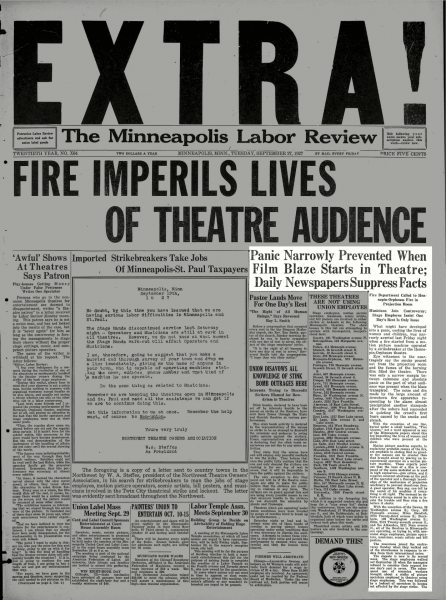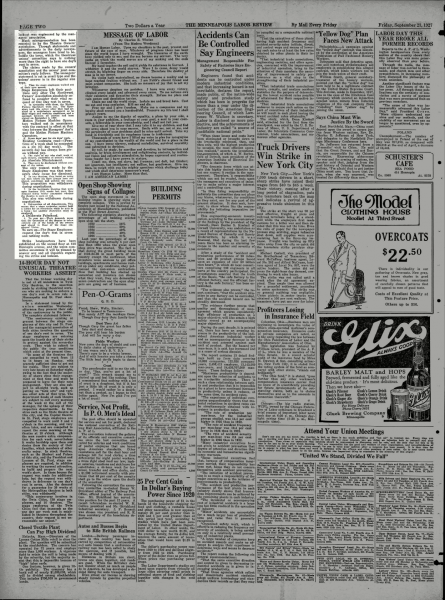| Artifact Type | Labor Newspapers, Sources |
| Publication | Minneapolis Labor Review |
| Number | X64 |
| Page Number | 1–2 |
| Place | Minneapolis, MN |
| Publication Date | September 27, 1927 |
| Transcript | Show/Hide |
|
Headline: “Panic Narrowly Prevented When Film Blaze Starts in Theatre; Daily Newspapers Suppress Facts” Subhead: Fire Department Called to Hennepin–Orpheum Fire in Projection Room Musicians Join Controversy; Stage Employes Insist One Day’s Rest Is Only IssueWhat might have developed into a panic, costing the lives of women and children, was narrowly averted last Friday night when a fire started from a motion picture machine operated by a strikebreaker at the Hennepin–Orpheum theatre. Eye witnesses to the near-tragedy say the smoke poured out from the projection room and the fumes of the burning film filled the theatre. There was only a narrow margin between calmness and absolute panic on the part of what audience was present when the blaze transpired. The noise and din made by the large amount of downtown fire apparatus responding to the alarm almost precipitated another stampede after the ushers had succeeded in quieting the crowd’s first fears caused by the smoke and stench. With the exception of one line, buried under a small headline, “Fire Alarms,” not a word appeared in any of the Minneapolis papers about this fire imperiling the lives of women and children who were present at the show. Motion picture machine experts, in explaining probably causes of the fire, are emphatic in stating that no greater fire menace can be created than that brought about by placing an inexperienced operator on a motion picture machine. These experts point out that the base of a film is composed of the same material as is used in high explosives—gun cotton, and it requires constant alertness on the part of the operator and a thorough knowledge of the mechanism of projection machinery to prevent disastrous fires. A good operator, they say, can tell by the sound of his machine if everything is all right. The moment he detects a strange sound he is able to locate the trouble and thus stop a fire before it starts. With the exception of the Dewey, 38 Washington avenue S.; Cozy, 405 Plymouth avenue; Miles Standish, 3736 Twenty-third avenue S.; Stockholm, 103 Washington avenue S., and the Alhambra, 3211 Penn avenue N. all of the theatres in Minneapolis are operating, or trying to, with nonunion stage employees, picture operators, musicians, scenic artists and bill posters. The musicians joined the controversy Sunday when they walked out of the showhouses in response to orders from their international union. The dispute is now in its second week. The stage employees walked out September 18 when the managers refused to consider their request for one day’s rest in seven. The subsequent use of nonunion workers brought about a strike of picture operators employed in theatres using stage employees. This was follwed by a lockout of operators in houses not affected by the stage strike. The lockout was engineered by the managers’ association. Much misrepresentation has been resorted to by the Threatre Owners’ association. Through statements and advertisements in the daily newspapers, the managers have tried to befuddle the issue, which the theatrical unions’ committee says is nothing more than the right to have one day’s rest in seven. The claims made by the owners’ association and the unions’ joint committee’s reply follows. The managers’ statement is set in small type and the unions’ answer is in the regular size type. [On this website, we will use italics for the managers’ statements instead.]
Strike headquarters have been established on the second floor at 818 Hennepin avenue, and the union committee announces it will be pleased to answer any and all inquiries regarding the strike and lockout. |
|
| Archive | Labor Review Archive Project |
| Read In Context | http://www.minneapolisunions.org/labor_review_archive_about.php |
| Citation | “Panic Narrowly Prevented When Film Blaze Starts in Theatre; Daily Newspapers Suppress Facts,” Minneapolis Labor Review, September 27, 1927. |
| Location | MinneapolisMinnesotaSaint Paul |
| Tags | 1920s1927September 1927 |

